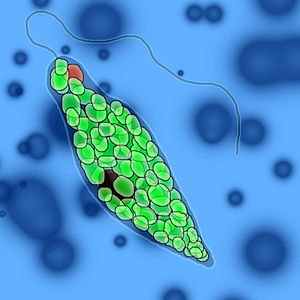- Euglena gracilis
-
Euglena gracilis 
Euglena gracilis
Systematik Domäne: Eukaryoten (Eucaryota) Stamm: Euglenozoa Klasse: Euglenoida Ordnung: Euglenales Gattung: Augentierchen (Euglena) Art: Euglena gracilis Wissenschaftlicher Name Euglena gracilis G.A.Klebs, 1883 Euglena gracilis ist eine Art der Protisten aus der Gattung der Augentierchen (Euglena).
Inhaltsverzeichnis
Merkmale
Euglena gracilis ist 35 bis 65 Mikrometer lang und 5 bis 15 Mikrometer breit. Das hintere Ende der schnell schwimmenden Zellen beschreibt einen weiten Kreis bei der Eigendrehung, die besonders stark wird, wenn die Zelle nicht mehr schwimmt.[1]
Die sechs bis zwölf abgeflachten, schildförmigen Chloroplasten sind groß und weisen zu beiden Seiten des mittigen Pyrenoids uhrglasförmige Paramylon-Hauben auf. Palmellae entstehen im Schlamm.[1]
Ökologie
Euglena gracilis ist eine seltene Süßwasserart, die in Gräben und Teichen mit verrottenden Blättern vorkommt.[1]
Bedeutung
Euglena gracilis ist ein bedeutender Modellorganismus insbesondere in der Chloroplasten-Physiologie, da Kulturen jahrelang ohne Licht gelagert werden können, aber rund 24 Stunden, nachdem sie dem Licht ausgesetzt wurden, wieder mit der Photosynthese beginnen. Einige Stämme (es existieren auch chloroplastenlose) finden Verwendung bei der Erforschung unter anderem von DNA und RNA, heterotropher Ernährung, Photorezeption und zum Fettstoffwechsel.[1]
Nachweise
- ↑ a b c d Gordon F. Leedale, Keith Vickerman: Euglenozoa, In: John J. Lee, Gordon F. Leedale, Phyllis Bradbury (Hrsg.): Illustrated Guide to the Protozoa, 2nd Edition. Bd. 2, Society of Protozoologists, Lawrence, Kansas 2000, ISBN 1-891276-23-9, S. 1142.
Weblinks
-
 Commons: Euglena gracilis – Sammlung von Bildern, Videos und Audiodateien
Commons: Euglena gracilis – Sammlung von Bildern, Videos und Audiodateien
Wikimedia Foundation.
